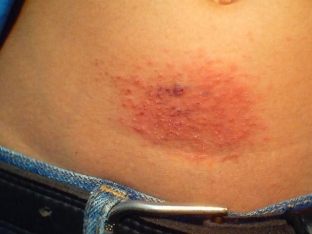Modern advances in the field of chemical, cosmetic, perfume industry not only make our lives easier and more beautiful, but also make the list of substances that cause allergic reactions in people much longer. One of these unpleasant reactions – contact dermatitis, which develops as an inflammatory response of the body to the touch of some objects, tissues, liquids and is manifested by itching, swelling, the appearance of papules and erosions. The sooner the cause of such a reaction of the body is clarified and eliminated, the sooner the patient will recover.
From what and in what cases does contact dermatitis develop
The essence of contact dermatitis is that when interacting with the skin, a substance that can cause a reaction of the body, with regular or sufficiently long contact, causes the development of sensitization of the body. How quickly and strongly will sensitization develop – depends on the concentration of the allergen substance and on the time of its contact with the skin. Of course, the state of the body itself also plays an important role. Contact dermatitis most often develops in patients with a predisposition to allergies. Increase the risk of developing sensitization chronic diseases and inflammatory processes, reduced immunity.
Among the causes that cause manifestations of contact dermatitis, the following are most often mentioned:
- household cleaning products,
- cosmetics and perfumery,
- synthetic fabrics,
- some metals from which fasteners on clothes and shoes are made, bijouterie,
- some plants,
- drugs,
- Cosmetic professional products with which the doctor is constantly in contact.
The risk of contact dermatitis is increased in patients who sweat excessively and in those who frequently exfoliate the skin, resulting in thinning of the stratum corneum.
How to identify signs of contact dermatitis
The main symptom of contact dermatitis, which distinguishes it from other allergic reactions, is that the skin becomes inflamed directly at the point of contact with the allergen. Skin changes may slightly go beyond the contact area, but the focus & nbsp; lesions are always clearly defined.
At first, the skin swells a little and turns red, then small pimples appear at the site of the lesion, quickly turning into bubbles, which open with the formation of erosions. In this case, the patient always complains of severe itching. Healing erosions with contact dermatitis gradually become covered with crusts, after their convergence, the skin flakes off for some time.
If the interaction of the skin with the allergen does not stop, contact dermatitis becomes chronic. In this case, the focus of inflammation on the skin already has blurred boundaries and spreads far from the point of contact, the skin becomes dry and flaky, thickened, and itches a lot. Itching can cause scratching at the site of contact dermatitis, which carries the risk of bacterial infection.

How to treat contact dermatitis, the prognosis of the disease
Diagnosis of contact dermatitis is not difficult, since the disease has & nbsp; characteristic symptoms confirmed by questioning the patient. If there are still doubts, skin tests are carried out. The basic principle of treatment of contact dermatitis is, firstly – in the elimination of the allergen that caused the inflammatory reaction, and secondly – in alleviating the condition of a patient suffering from severe allergic itching. Antihistamines, topical corticoids are used for treatment, and if necessary, – inside.
The prognosis of contact dermatitis depends entirely on how early contact with the allergen was eliminated and adequate treatment started. Usually, recovery occurs quickly and completely, but if the allergen continues to affect the skin, the process develops and generalizes, gradually capturing the entire body.







Add a comment